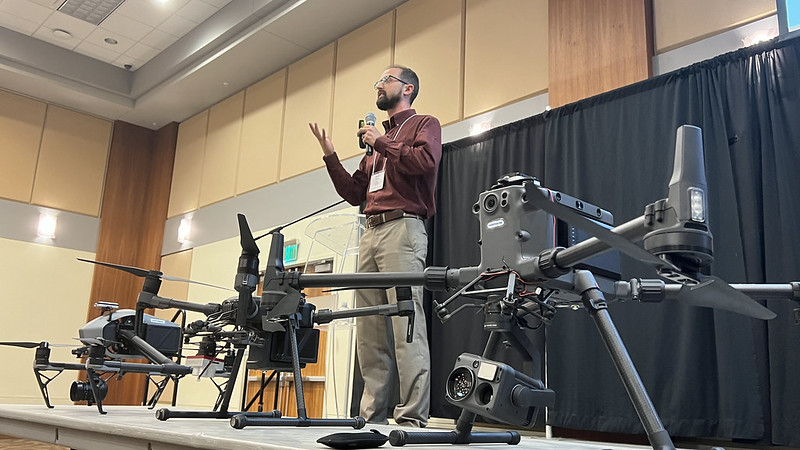Extension specialist bringing expanded drone, imaging education to Arkansas agents, growers
Oct. 11, 2023
By Ryan McGeeney
U of A System Division of Agriculture
Fast Facts:
- Davis hired to newly-created position incorporating drone use, imagery analysis
- Will train extension agents in remote sensing this fall
(405 words)
(Newsrooms: With file art of Jason Davis)
LITTLE ROCK — Imagery provided by satellites and unmanned aerial vehicles — commonly known as drones — is already changing the way producers farm their crops. As this technology becomes more prevalent, the Cooperative Extension Service is adapting to ensure that it will be able to provide growers, consultants and other industry professionals with modern tools for success.
Jason Davis, who joined the University of Arkansas System Division of Agriculture as an extension pesticide application specialist in 2014, has been studying the use of remote sensing technologies since 2019, when he acquired a UAV pilot license. That same year, the Arkansas Plant Board granted the Division of Agriculture access to a drone for a three-year period, and Davis began incorporating it in a drift analysis project.
“Since then, the use of drones has only been limited by our own creativity,” Davis said.
Recently, the Division of Agriculture hired Davis, who completed his Ph.D. in 2022, to fulfill the newly-created position of assistant professor of remote sensing and pesticide application extension specialist. The position reflects an increasing effort to formalize agent training in the use of drone and satellite imagery and analysis of the data it can provide.
“There are a plethora of crop-sensing capabilities and analysis, including weed detection,
vegetative health, bees analysis, tracking of livestock and wildlife, irrigation efficiencies and forestry analysis,” he said.
Professional development
Davis, along with Aurelie Poncet, assistant professor of precision agriculture and
remote sensing for the Division of Agriculture, will present two in-service training
seminars for extension agents in November.
“The class is aimed at county agents, so they can work at being better assets for their producers on these technologies,” Davis said.
An additional key to putting remote sensing imagery to use is acquiring and using both software and hardware to analyze the imagery in an actionable way, Davis said.
“It’s one thing to fly a drone, it’s another to have a decision model that will help you act on the information you’ve gained,” he said. “A lot of these technologies are difficult to access and may require the right computer or specialized software to manage them correctly. These specifications often make it difficult to incorporate these technologies into production systems.
“Through an extension scope, I’m trying to bridge the gap and make some of these technologies more accessible and practical to agents, consultants and producers alike,” Davis said.
Agents interested in attending the upcoming training should contact Davis at jdavis@uada.edu.
To learn about extension programs in Arkansas, contact your local Cooperative Extension Service agent or visit www.uaex.uada.edu. Follow us on Twitter and Instagram at @AR_Extension. To learn more about Division of Agriculture research, visit the Arkansas Agricultural Experiment Station website: https://aaes.uada.edu/. Follow on Twitter at @ArkAgResearch. To learn more about the Division of Agriculture, visit https://uada.edu/. Follow us on Twitter at @AgInArk.
About the Division of Agriculture
The University of Arkansas System Division of Agriculture’s mission is to strengthen agriculture, communities, and families by connecting trusted research to the adoption of best practices. Through the Agricultural Experiment Station and the Cooperative Extension Service, the Division of Agriculture conducts research and extension work within the nation’s historic land grant education system.
The Division of Agriculture is one of 20 entities within the University of Arkansas System. It has offices in all 75 counties in Arkansas and faculty on five system campuses.
The University of Arkansas System Division of Agriculture offers all its Extension and Research programs to all eligible persons without regard to race, color, sex, gender identity, sexual orientation, national origin, religion, age, disability, marital or veteran status, genetic information, or any other legally protected status, and is an Affirmative Action/Equal Opportunity Employer.
# # #
Media Contact:
Ryan McGeeney
rmcgeeney@uada.edu
@Ryan_McG44
501-671-2120
